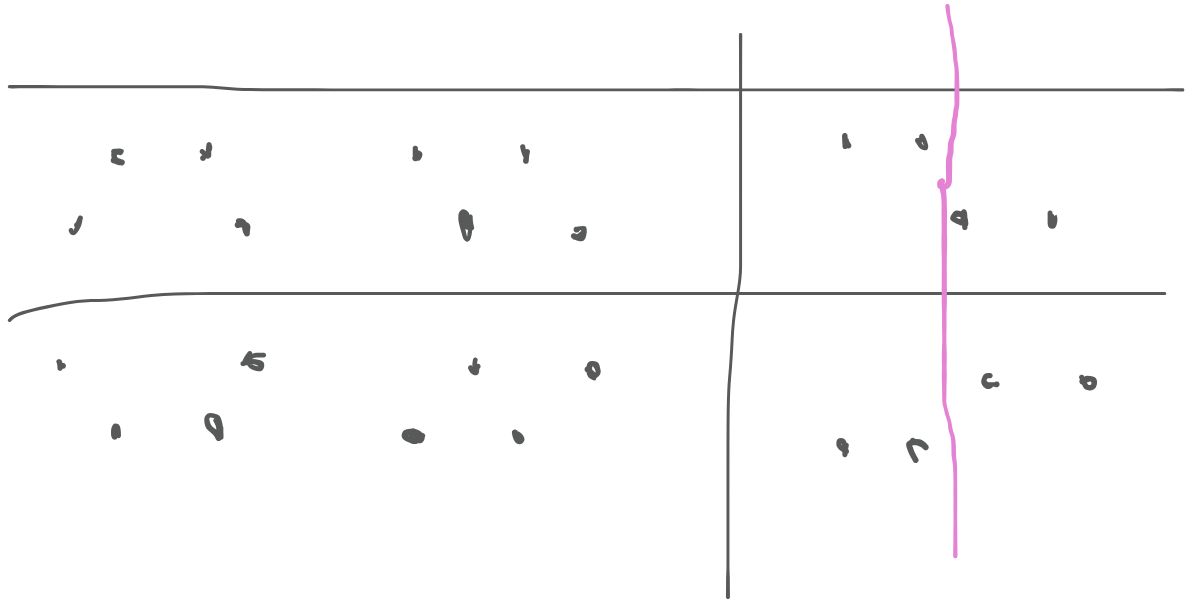题目
给定两个由一些 闭区间 组成的列表,firstList 和 secondList ,其中 firstList[i] = [starti, endi] 而 secondList[j] = [startj, endj] 。每个区间列表都是成对 不相交 的,并且 已经排序 。
返回这 两个区间列表的交集 。
形式上,闭区间 [a, b](其中 a <= b)表示实数 x 的集合,而 a <= x <= b 。
两个闭区间的 交集 是一组实数,要么为空集,要么为闭区间。例如,[1, 3] 和 [2, 4] 的交集为 [2, 3] 。
示例 1:

输入:firstList = [[0,2],[5,10],[13,23],[24,25]], secondList = [[1,5],[8,12],[15,24],[25,26]]
输出:[[1,2],[5,5],[8,10],[15,23],[24,24],[25,25]]
示例 2:
输入:firstList = [[1,3],[5,9]], secondList = []
输出:[]
示例 3:
输入:firstList = [], secondList = [[4,8],[10,12]]
输出:[]
示例 4:
输入:firstList = [[1,7]], secondList = [[3,10]]
输出:[[3,7]]
提示:
0 <= firstList.length, secondList.length <= 1000firstList.length + secondList.length >= 10 <= starti < endi <= 10^9endi < starti+10 <= startj < endj <= 10^9endj < startj+1
解题
方法一:双指针法
思路分析
由于两个区间列表都已经排序,我们可以使用双指针法来寻找交集。
我们初始化两个指针i和j分别指向第一个区间的起始位置,然后进行如下操作:
- 如果firstList[i]和secondList[j]有交集,则将交集加入结果集中。
- 如果firstList[i]的结束位置小于secondList[j]的结束位置,则i指针向后移动,否则j指针向后移动。
重复上述操作直到遍历完任意一个区间列表。
代码实现
主要观察交集的判断

class Solution:
def intervalIntersection(self, firstList: List[List[int]], secondList: List[List[int]]) -> List[List[int]]:
result = [] # 保存交集的结果集
i, j = 0, 0
while i < len(firstList) and j < len(secondList):
a_start, a_end = firstList[i]
b_start, b_end = secondList[j]
# 检查区间是否有交集
if a_end >= b_start and b_end >= a_start:
result.append([max(a_start, b_start), min(a_end, b_end)])
# 移动指针
if a_end < b_end:
i += 1
else:
j += 1
return result
class Solution:
def intervalIntersection(self, firstList: List[List[int]], secondList: List[List[int]]) -> List[List[int]]:
l1 , l2 = 0, 0
result = []
while l1 < len(firstList) and l2 < len(secondList):
if firstList[l1][1] < secondList[l2][0]:
l1 += 1
elif firstList[l1][0] > secondList[l2][1]:
l2 += 1
elif firstList[l1][1] <= secondList[l2][1]:
result.append([max(firstList[l1][0],secondList[l2][0]), min(firstList[l1][1],secondList[l2][1])])
l1 += 1
elif firstList[l1][1] >= secondList[l2][1]:
result.append([max(firstList[l1][0],secondList[l2][0]), min(firstList[l1][1],secondList[l2][1])])
l2 += 1
return result
class Solution:
def intervalIntersection(self, A: List[List[int]], B: List[List[int]]) -> List[List[int]]:
ans = []
i = j = 0
while i < len(A) and j < len(B):
# Let's check if A[i] intersects B[j].
# lo - the startpoint of the intersection
# hi - the endpoint of the intersection
lo = max(A[i][0], B[j][0])
hi = min(A[i][1], B[j][1])
if lo <= hi:
ans.append([lo, hi])
# Remove the interval with the smallest endpoint
if A[i][1] < B[j][1]:
i += 1
else:
j += 1
return ans
作者:LeetCode
链接:https://leetcode.cn/problems/interval-list-intersections/solution/qu-jian-lie-biao-de-jiao-ji-by-leetcode/
来源:力扣(LeetCode)
著作权归作者所有。商业转载请联系作者获得授权,非商业转载请注明出处。
时间复杂度分析
假设第一个区间列表的长度为m,第二个区间列表的长度为n。由于我们只需要遍历两个区间列表一次,因此时间复杂度为O(m+n)。
空间复杂度分析
由于只需要保存交集的结果集,空间复杂度为O(1)。






















 1130
1130











 被折叠的 条评论
为什么被折叠?
被折叠的 条评论
为什么被折叠?








